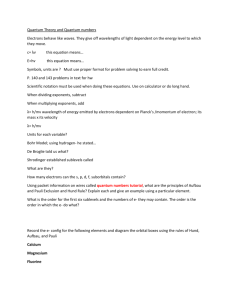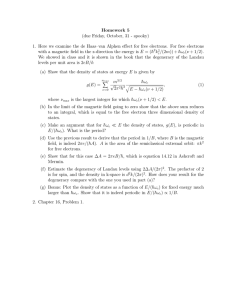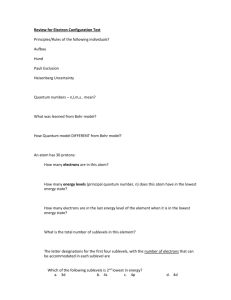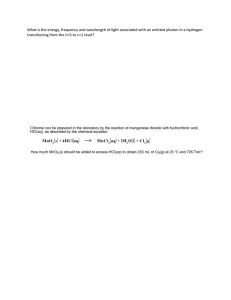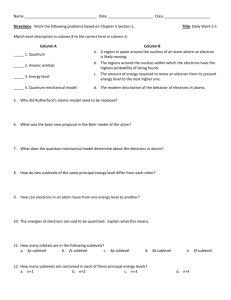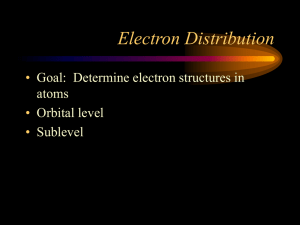Physics 212 – Problem Set 10 – Spring 2010 2s 2p
advertisement
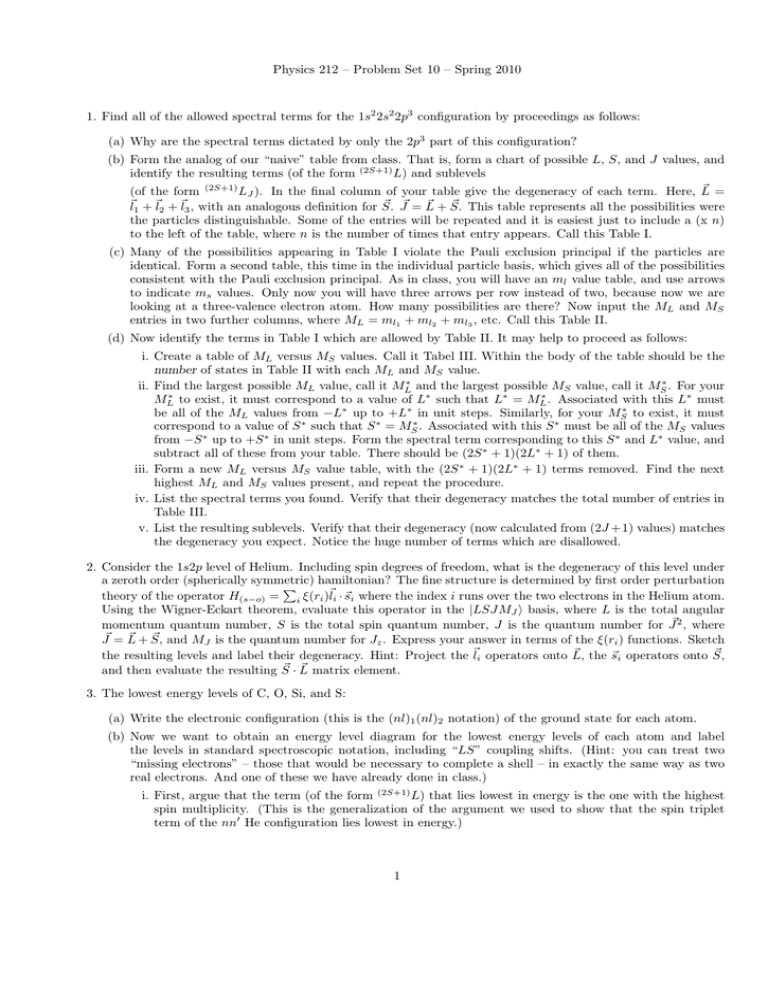
Physics 212 – Problem Set 10 – Spring 2010 1. Find all of the allowed spectral terms for the 1s2 2s2 2p3 configuration by proceedings as follows: (a) Why are the spectral terms dictated by only the 2p3 part of this configuration? (b) Form the analog of our “naive” table from class. That is, form a chart of possible L, S, and J values, and identify the resulting terms (of the form (2S+1) L) and sublevels ~ = (of the form (2S+1) LJ ). In the final column of your table give the degeneracy of each term. Here, L ~l1 + ~l2 + ~l3 , with an analogous definition for S. ~ J~ = L ~ + S. ~ This table represents all the possibilities were the particles distinguishable. Some of the entries will be repeated and it is easiest just to include a (x n) to the left of the table, where n is the number of times that entry appears. Call this Table I. (c) Many of the possibilities appearing in Table I violate the Pauli exclusion principal if the particles are identical. Form a second table, this time in the individual particle basis, which gives all of the possibilities consistent with the Pauli exclusion principal. As in class, you will have an ml value table, and use arrows to indicate ms values. Only now you will have three arrows per row instead of two, because now we are looking at a three-valence electron atom. How many possibilities are there? Now input the ML and MS entries in two further columns, where ML = ml1 + ml2 + ml3 , etc. Call this Table II. (d) Now identify the terms in Table I which are allowed by Table II. It may help to proceed as follows: i. Create a table of ML versus MS values. Call it Tabel III. Within the body of the table should be the number of states in Table II with each ML and MS value. ii. Find the largest possible ML value, call it ML∗ and the largest possible MS value, call it MS∗ . For your ML∗ to exist, it must correspond to a value of L∗ such that L∗ = ML∗ . Associated with this L∗ must be all of the ML values from −L∗ up to +L∗ in unit steps. Similarly, for your MS∗ to exist, it must correspond to a value of S ∗ such that S ∗ = MS∗ . Associated with this S ∗ must be all of the MS values from −S ∗ up to +S ∗ in unit steps. Form the spectral term corresponding to this S ∗ and L∗ value, and subtract all of these from your table. There should be (2S ∗ + 1)(2L∗ + 1) of them. iii. Form a new ML versus MS value table, with the (2S ∗ + 1)(2L∗ + 1) terms removed. Find the next highest ML and MS values present, and repeat the procedure. iv. List the spectral terms you found. Verify that their degeneracy matches the total number of entries in Table III. v. List the resulting sublevels. Verify that their degeneracy (now calculated from (2J +1) values) matches the degeneracy you expect. Notice the huge number of terms which are disallowed. 2. Consider the 1s2p level of Helium. Including spin degrees of freedom, what is the degeneracy of this level under a zeroth order (spherically symmetric) hamiltonian? The fine structure is determined by first order perturbation P theory of the operator H(s−o) = i ξ(ri )~li · ~si where the index i runs over the two electrons in the Helium atom. Using the Wigner-Eckart theorem, evaluate this operator in the |LSJMJ i basis, where L is the total angular momentum quantum number, S is the total spin quantum number, J is the quantum number for J~2 , where ~ + S, ~ and MJ is the quantum number for Jz . Express your answer in terms of the ξ(ri ) functions. Sketch J~ = L ~ the ~si operators onto S, ~ the resulting levels and label their degeneracy. Hint: Project the ~li operators onto L, ~ ·L ~ matrix element. and then evaluate the resulting S 3. The lowest energy levels of C, O, Si, and S: (a) Write the electronic configuration (this is the (nl)1 (nl)2 notation) of the ground state for each atom. (b) Now we want to obtain an energy level diagram for the lowest energy levels of each atom and label the levels in standard spectroscopic notation, including “LS” coupling shifts. (Hint: you can treat two “missing electrons” – those that would be necessary to complete a shell – in exactly the same way as two real electrons. And one of these we have already done in class.) i. First, argue that the term (of the form (2S+1) L) that lies lowest in energy is the one with the highest spin multiplicity. (This is the generalization of the argument we used to show that the spin triplet term of the nn0 He configuration lies lowest in energy.) 1 ~ · S, ~ ii. Now apply the “LS” coupling shifts to the lowest term. The shifts are dictated by ∆E = ζ(L, S)L which you know how to evaluate in the L, S, J, MJ basis. ζ(L, S) is just a constant if L and S are constant (which they are within one (2S+1) L term). iii. Compare your results with the experimental measurement of the lowest levels, where the first is arbitrarily set to zero. (These are the levels, not the separation between levels.) C O Si S 0 16.4 27.1 0 158.5 226.5 0 77.2 223.3 0 396.0 573.6 What information does this give you on the sign of ζ(L, S) for the different atoms? 4. Analyzing Ca lines. It is observed that there are six lines (representing the energy of photons emitted between sublevels) lying close together near 4450 Angstroms. Setting the lowest frequency line arbitrarily at zero, lines exist at zero, 3.7 cm−1 , 9.3 cm−1 , 105.8 cm−1 , 109.7 cm−1 , and 158.0 cm−1 . Calling these lines a, b, c, d, e, and f from left to right, sketch them versus cm−1 with the following intensities (height of line) a = 0.5, b = 4.5, c = 25, d = 5, e = 14, and f = 6.5. You see that there are three lines clustered together, then a gap until two lines clustered together, and finally a third line appearing after another gap in wavenumber. The ground state of Ca has the outermost (most loosely bound) electrons in the configuration 4s2 . Assume that it is transitions from the excited state of one of these electrons which gives rise to the observed frequency spectrum. (a) What is the dipole selection rule for individual electron angular momentum quantum numbers? That is, give the selection rule in terms of the change allowed in l2 . l1 is assumed to remain at zero since one of the electrons remains in the 4s orbital. (b) Use the three lowest excited configurations ((4s4l), l = 1, 2, 3) of Ca to find all of the spectral terms ((2S+1) L) which result. Here, since the electrons occupy different orbitals, there is no confusion over Pauli exclusion issues. Check that you have all of the spectral terms by making sure that the total degeneracy is maintained as you go from the individual particle basis to the coupled particle basis. ~ = ~l1 +~l2 ? (c) How does your selection rule in terms of ∆l2 translate into a selection rule in terms of ∆L, where L Also give the restrictions of ∆S and ∆J (again for a dipole transition). (d) Now sketch the sublevels (specified by the J quantum number), grouping together those of a given L and S value. You need not be concerned with whether the sublevels are regular or inverted with respect to ~ ·S ~ is positive or negative); just pick increasing J (that is, whether the sign of the coefficient in front of L one and stick with it for all terms. (e) By applying your selection rules, and requiring that the total number of possible transitions is six, you will be able to reject all possibilities but those involving transitions between two sets of (two) terms. Sketch those levels and the allowed transitions. (f) Now, given the interval rule ∆E(J) − ∆E(J − 1) = ζJ, form ratios of level spacings. The idea here is that spacings within a given term are proportional to one another. Taking ratios removes the proportionality constant. This will help you narrow down the possible source of the experimental lines. (g) Verify your choice of assignments of the observed spectral lines to the transitions you have chosen by checking that the intensities of the lines is as expected: Within a given term, the different decay intensities for different J levels is given by the multiplicity of that level. So, for instance, if within a term you have J values of 1 and 2, the relative intensity of the lines will be 3:5. In order to get the intensity of a given level, you must add up the intensities of all its decay modes. 2
